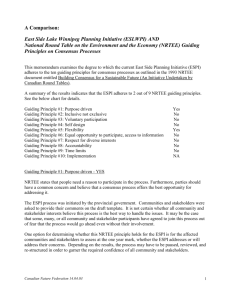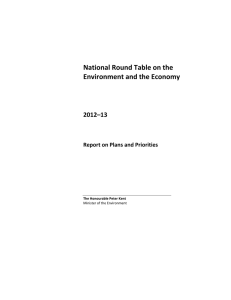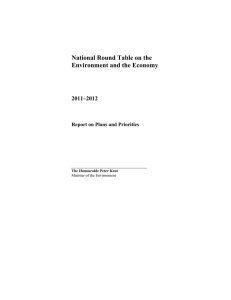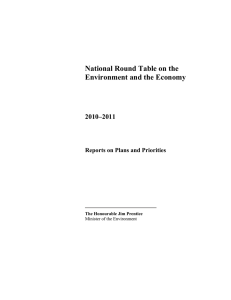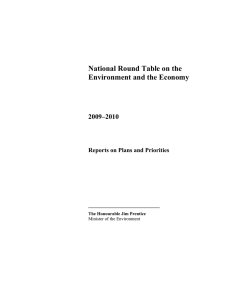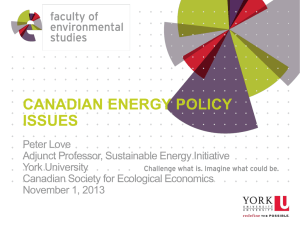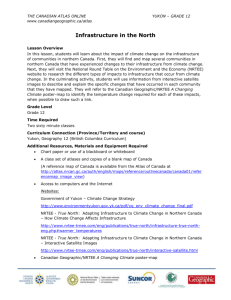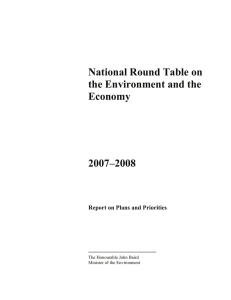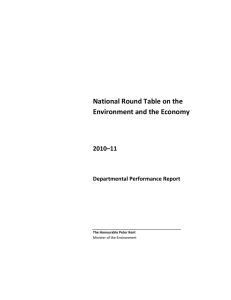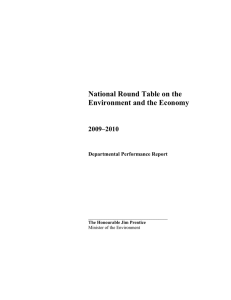National Round Table on the Environment and the Economy 2008–2009
advertisement
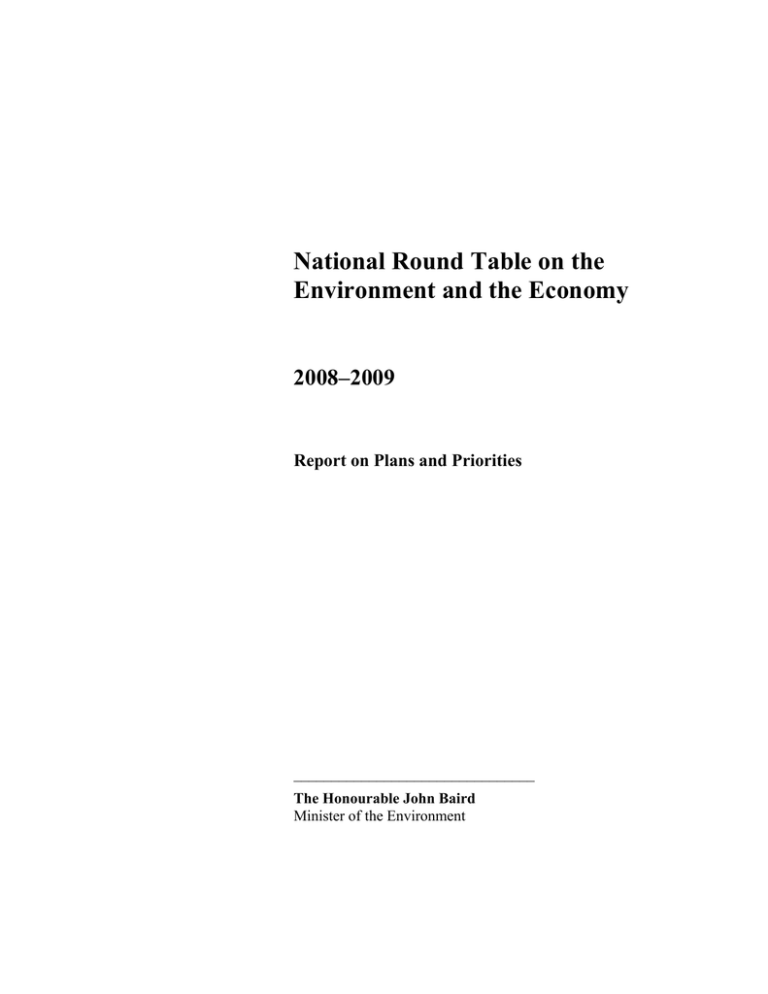
National Round Table on the Environment and the Economy 2008–2009 Report on Plans and Priorities ________________________________ The Honourable John Baird Minister of the Environment 1 2 Table of Contents Message from the President and CEO ............................................................................. i Section 1 1.1 1.2 1.3 1.4 1.5 1.6 1.7 OVERVIEW.....................................................................................................1 Management Representation Statement.............................................................1 Purpose...............................................................................................................2 Organizational Information................................................................................2 Program Activity Architecture (PAA) ...............................................................4 Summary Information........................................................................................6 Program Activities by Strategic Outcome .........................................................6 Departmental Plans and Priorities......................................................................7 1.7.1 Operating Approach...............................................................................7 1.7.2 Internal and External Factors .................................................................7 1.7.3 Priorities.................................................................................................8 Section 2 ANALYSIS OF PROGRAM ACTIVITY BY STRATEGIC OUTCOME .....................................................................12 2.1 Strategic Outcome............................................................................................12 2.2 Program Activity (PA).....................................................................................12 2.3 Financial and HR Resources............................................................................13 2.4 Performance Measurement ..............................................................................13 2.5 Plans for 2008–2009 and Beyond ....................................................................13 2.5.1 Produce Advice....................................................................................13 2.5.2 Promote Advice ...................................................................................17 Section 3 SUPPLEMENTARY INFORMATION.......................................................21 Section 4 OTHER ITEMS OF INTEREST .................................................................23 4.1 Round Table Members.....................................................................................23 4.2 NRTEE Contact Information ...........................................................................25 3 4 Message from the President and CEO Created by the Prime Minister in 1988 as an independent policy advisory body, the National Round Table on the Environment and the Economy (NRTEE, or Round Table) had its status formalized in a 1993 Act of Parliament. The purpose of the Round Table, according to the Act, is “to play the role of catalyst in identifying, explaining, and promoting, in all sectors of Canadian society and in all regions of Canada, principles and practices of sustainable development.” The NRTEE examines the environmental and economic implications of priority issues and offers independent advice on how to address them. Our advice is primarily directed to the federal government, but also targets other levels of government and key sectors of the economy in order to influence policy development and decisions. Over the past 20 years, by combining the expertise and experience of our members with a unique multistakeholder approach, we have learned to integrate the diverse views of many sectors across the country. In so doing, we have earned a reputation for working effectively in often contentious areas and providing relevant, independent, and credible advice. After undergoing considerable transition in reporting relationships and internal leadership over the past few years, the NRTEE is now entering a trajectory during which it expects to consolidate its profile and mandate while continuing to be proactive and progressive in its work. We will be building on recent successes and initiatives put in place in earlier reporting periods. We will also be guided by lessons learned from past performance as reflected in the 2006–2007 Departmental Performance Report. The Round Table has identified several key overarching objectives for 2008–2009 and beyond. Most importantly, we plan to develop a clearer strategic coherence and focus in our research and policy program, create stronger internal policy and communications capacities, and undertake new collaborative and engagement opportunities with stakeholders. Achieving these objectives will enable us to more effectively produce and disseminate our advice and recommendations, and will enhance our credibility and influence with stakeholders. NRTEE has a broad legislated mandate; however, given the limited resources of the organization, we recognize that on a practical level, we have to be strategic and focused in our planning to maximize our effectiveness. For 2008, we will complete an alreadyinitiated program examining challenges related to adaptation to climate change in Canada’s North. We will also devote considerable resources to identify and implement a new research agenda, most of which will continue to be within the area of climate change. Our choices on these issues will be informed by extensive discussions with our members, key stakeholders, and the government. In addition, we will institute a strategic outlook and research function that will help us understand which “over-the-horizon” issues at the nexus of environment and the economy will have increased relevance to our work, and to Canadian society in general. Message from the President and CEO i In our operations, we will implement the results of a management review of our internal roles and responsibilities to ensure that our current structure is capable of delivering on the ambitious plans we are making. It will also help us to identify where additional resources might be required and savings can be achieved. With our members’ approval, the NRTEE will implement newly revised bylaws to regulate how we conduct and manage ourselves. The bylaws have been updated to correspond to current assumptions and expectations in relation to governance within the federal government. They clearly lay out the roles, responsibilities, and accountabilities of the members, the Chairperson, the President, and the Secretariat. Because it is important that the NRTEE demonstrate leadership on policy issues where it seeks to influence others, the Round Table will move toward becoming a carbon neutral operation within the 2008–2009 fiscal year. Finally, fall 2008 will mark the 20th anniversary of the establishment of the Round Table. As we approach this significant milestone, we will reflect on the accomplishments and lessons learned over the past twenty years, and consider how we can build on these as the foundation for our future planning and efforts in the years ahead. _______________________________ David McLaughlin President and CEO Message from the President and CEO ii Section 1: OVERVIEW 1.1 Management Representation Statement I submit for tabling in Parliament, the 2008–2009 Report on Plans and Priorities (RPP) for the National Round Table on the Environment and the Economy. This document has been prepared based on the reporting principles contained in Guide for the Preparation of Part III of the 2008–09 Estimates: Reports on Plans and Priorities and Departmental Performance Reports: • It adheres to the specific reporting requirements outlined in the Treasury Board of Canada Secretariat guidance; • It is based on the department’s strategic outcome(s) and Program Activity Architecture that were approved by the Treasury Board; • It presents consistent, comprehensive, balanced and reliable information; • It provides a basis of accountability for the results achieved with the resources and authorities entrusted to it; and • It reports finances based on approved planned spending numbers from the Treasury Board of Canada Secretariat. _______________________________ David McLaughlin President and CEO Section 1: Overview 1 1.2 Purpose The purpose of the Round Table is to play the role of catalyst in identifying, explaining and promoting, in all sectors of Canadian society and in all regions of Canada, principles and practices of sustainable development. The NRTEE interprets this broad mandate through a strategic focus on issues of national interest at the intersection of the environment and the economy. Through its work, the NRTEE strives to influence policy development and decisions on issues pertaining to the environment and the economy. These promote economic prosperity for all Canadians while striving to preserve the environment for current and future generations. General information about the NRTEE and its membership can be found on the agency’s website at www.nrtee-trnee.ca. 1.3 Organizational Information The Round Table reports to Parliament through the Minister of the Environment. The organization consists of up to 24 members and a Chairperson who are appointed in a part-time capacity by the Governor in Council. The agency draws on the insight and experience of these individuals to meet its mandate. The members represent different regions of Canada and are distinguished leaders in business, labour, universities, environmental organizations, Aboriginal communities, and municipalities. (See a list of members in Section 4.) A Secretariat in Ottawa, headed by a President and CEO, supports the members. The Round Table normally meets four times each year in plenary sessions where members discuss priorities and review and approve the work of the Secretariat. Figure 1.1 depicts the agency’s internal organization and relationship to the government. Section 1: Overview 2 Figure 1.1 Section 1: Overview 3 1.4 Program Activity Architecture (PAA) In June 2007, the Treasury Board Secretariat approved changes to the NRTEE’s PAA. The revised wording for the Strategic Outcome provides a more accurate reflection of the NRTEE’s mandate and work. The elimination of the sub-activity level in the revised version ensures a closer alignment with the TBS’s approach. This RPP is based on the revised PAA. The changes, presented in the crosswalk below, did not require any redistribution of financial resources. Program Activity Architecture (PAA) Crosswalk Previous PAA Revised PAA Strategic Outcome Federal policy development on environment and economy issues and decisions in other key sector are influenced by NRTEE advice on selected issues. Federal policy development and decisions in other key sectors are influenced by advice on sustainable development issues pertaining to the environment and the economy. Program Activity Provide advice on environment and economy issues Advisory program on environment and economy issues Program Sub-Activities Produce advice: Identify new knowledge; convene and consult stakeholders None Promote advice: Advise federal clients; promote to other key sectors Section 1: Overview 4 Table 1.1. Voted and Statutory Items displayed in the Main Estimates ($ thousands) Vote or Statutory Item Truncated Vote or Statutory Wording 2008–09 Main Estimates 2007–08 Main Estimates 4,723.0 4,704.0 20 Program expenditures (S) Contributions to employee benefit plans 411.0 432.0 (S) Expenditures pursuant to Paragraph 29.1(1) of the Financial Administration Act 20.0 20.0 5,154.0 5,156.0 Total Agency Table 1.2. Departmental Planned Spending Table and Full-time Equivalents ($ thousands) Forecast Spending 2007–08 Planned Spending 2008–09 Planned Spending 2009–10 Planned Spending 2010–11 Program Activity: Advisory Program on Environment and Economy Issues Budgetary Main Estimates (gross) 5,136.0 5,134.0 5,134.0 5,134.0 Non-budgetary Main Estimates (gross) 20.0 5,156.0 20.0 5,154.0 20.0 5,154.0 20.0 5,154.0 414.0 5,568.0 27 417.0 5,571.0 27 421.0 5,575.0 27 Total Main Estimates Adjustments Supplementary Estimates Operating budget carry-forward Collective bargaining adjustments Total Adjustments Total Planned Spending Plus: Cost of services received without charge Total Departmental Spending Full-time Equivalents Section 1: Overview 236.1 20.0 256.1 5,412.1 410.0 5,822.1 27 5 1.5 Summary Information Table 1.3. Financial Resources ($ thousands) 2008–09 2009–10 2010–11 $5,154.0 $5,154.0 $5,154.0 2008–09 2009–10 2010–11 27 27 27 Table 1.4. Human Resources (FTEs) Table 1.5. Departmental Priorities Name Type Priority #1: Produce and promote advice on environment and economy issues of national relevance. Ongoing Priority #2: Apply sound management practices in operations Ongoing 1.6 Program Activities by Strategic Outcome Contribution to Priorities: The NRTEE has a single strategic outcome and a single program activity. Both contribute directly to the NRTEE’s two stated priorities. Table 1.6. Program Activity by Strategic Outcome Strategic Outcome Federal policy development and decisions in other key sectors are influenced by advice on sustainable development issues pertaining to the environment and the economy. Planned Spending ($ thousands) Program Activity Expected Results • • • Advisory program on environment and economy issues • • • Section 1: Overview High quality research Effective consultations Useful recommendations and results Effective communication of recommendations Increased awareness and understanding of issues and solutions Sound management 2008–09 5,154.0 2009–10 5,154.0 2010–11 5,154.0 6 1.7 Departmental Plans and Priorities The NRTEE has a single strategic outcome, namely federal policy development and decisions in other key sectors are influenced by advice on sustainable development issues pertaining to the environment and the economy. All of the agency’s plans, priorities, and activities are directed toward its achievement. 1.7.1 Operating Approach Issues to be examined by the NRTEE are identified through an internal screening and scoping process, in which the final decisions reflect current political, environmental or economic priorities, and members’ combined interests. The NRTEE also responds to specific requests from the federal government, often within short time frames. The NRTEE has adapted its approach to respond effectively to these requests, balancing stakeholder consultation with a reliance on members’ expertise and advice. The Secretariat, headed by a President and CEO, provides program management, policy and research analysis, communications, and administrative services to the NRTEE members. 1.7.2 Internal and External Factors The NRTEE’s success depends on its ability to influence the government’s approach to important sustainable development issues. To accomplish this, the NRTEE must produce and promote relevant, neutral, and credible advice in a timely manner. Its ability to do so is affected by both external and internal factors. These are discussed below. • The key indicator of the NRTEE’s performance is its ability to influence government policy development. In Canada, particularly for the issues typically examined by the NRTEE, federal policy is not developed in isolation. It is affected by the government’s relationships with other Canadian and international jurisdictions, and by a host of other factors over which the NRTEE has no control, creating a complex decision-making environment. • The emergence of the environment, and climate change in particular, as a key priority for Canadians puts the Round Table firmly in the spotlight due to the focus of its current work. This creates both an opportunity and a risk. The NRTEE is well positioned to provide strategic assistance on this issue to the government. However, failure to produce effective advice in a timely manner could harm the NRTEE’s reputation. The agency must address this risk by applying a more focused research and decision-making approach that is well-managed by the members and the Secretariat. • The NRTEE has undergone considerable transition in reporting relationships and leadership over the past few years, but is now entering a clear trajectory during which Section 1: Overview 7 it expects to consolidate its profile and mandate. Increased stability, certainty, and a renewed focus on a clear set of strategic objectives are expected to have a positive impact on the agency’s performance. • New members are appointed to the Round Table on a rotating basis. The timing of the appointments typically does not take the NRTEE’s planning schedule into consideration. To avoid the risk of delaying the Round Table’s work, orientation for new members is undertaken quickly to make the transition as seamless as possible. 1.7.3 Priorities The NRTEE has two overarching priorities for 2008–2009. Priority #1: To produce and promote advice to decision makers on environment and economy issues Although it has a relatively small budget of approximately $5 million, the agency nevertheless delivers an increasing amount of advice on issues of national importance— advice that decision makers in and beyond the federal government have said provides a valuable contribution to Canadians’ knowledge about issues at the nexus of the environment and the economy. The NRTEE’s first priority entails producing the advice, then promoting it. PRODUCE ADVICE The Round Table strives to provide advice that is timely, actionable, and relevant to the government’s priorities. Producing the advice entails conducting research and analysis on selected issues, and convening experts to ensure balance and credibility. As a group, the NRTEE members review, discuss, and approve the resulting policy recommendations. The culmination of this effort is a report that presents the findings, analysis, and policy advice from the research and consultation process. Noteworthy activities for 2008–2009 are summarized below; further details are provided in Section 2. Generate New Policy Advice Generating policy advice is a core function for the Round Table. In the upcoming period, the NRTEE plans to develop a clearer, more strategic coherence and focus for its work as it selects a suite of policy issues to examine in the short to medium term. The focus will mostly be on topics within the general area of climate change, an area for which the organization has developed a recognized expertise and where it is in a unique position to provide advice to federal decision makers and other stakeholders. Possible issues for further examination include the following: Section 1: Overview 8 • Carbon pricing: Instrument design and implementation • Improved greenhouse gas (GHG) emissions forecasting and reporting in Canada: Learning from international best practices • Innovation and deployment of specific “wedge” technologies to achieve GHG emission reductions. • The economics and cost benefits of climate change in Canada • Economic instruments for water management in Canada. In addition, the NRTEE will complete its work on Climate Change Adaptation Policy. This program was launched in June 2006. Its purpose is to examine how Canadian public policy influences the way in which Canada’s communities and economic sectors in the North plan for and manage the effects of climate change. Establish a Strategic Outlook Function The NRTEE plans to put in place a new strategic outlook function. The goal will be to undertake intelligence gathering and analysis in order to identify forthcoming priority areas for research where the issues are not fully known or appreciated, or public policy discussion is not yet fully engaged. Respond to Government References The NRTEE recognizes the importance of responding to government “references” or requests for advice on specific issues. None have yet been identified for 2008–2009. By staggering the start dates of new initiatives and by undertaking a mix of short-term projects and long-term programs, the Round Table will strive to increase its flexibility and position itself to be able to deliver on these requests without needing to curtail other work in progress. Nevertheless, timely presentation of such references with consideration for the resource implications for the NRTEE would assist in this regard. Comply with Bill C-288 The NRTEE will comply with its legislated responsibilities under the Kyoto Protocol Implementation Act with respect to the government’s Climate Change Plan and Statement. PROMOTE ADVICE The NRTEE seeks opportunities to promote its advice and policy recommendations as a means to achieving its strategic outcome. Activities for 2008–2009 are summarized below; further details are provided in Section 2. Section 1: Overview 9 Maintain Program and Corporate Communications Activities On completion of a program or an activity, the agency promotes its findings and advice through a variety of communications channels to reach targeted decision makers and opinion leaders across the country. This step is crucial for raising awareness and understanding, and for influencing policy development. The NRTEE maintains databases of selected individuals in stakeholder groups as a starting point for these initiatives. A key activity in 2008–2009 will be the release of the report on the NRTEE’s program on adaptation to climate change together with supporting communications activities. Ongoing communications about the NRTEE at the corporate level is a key component of the NRTEE’s overall approach to communications. Tools include the NRTEE website, ebriefs, and newsletters. Improve Strategic Communications One of the NRTEE’s objectives for this planning period is to improve the quality and reach of its external communications. In so doing, it will increase the visibility of the NRTEE and its work among decision makers in key sectors, and enhance its credibility. This will, in turn, significantly increase the potential for achieving the NRTEE’s strategic outcome, namely to influence policy. Pursue Collaborative Arrangements with Other Organizations The NRTEE recognizes that its effectiveness could be increased exponentially by entering into beneficial collaborative arrangements with appropriate partners, while retaining its independence. Leveraging its limited resources through these types of arrangements would provide opportunities to increase the scope and depth of its research and analysis, and extend its reach to external stakeholders. In 2008–2009, the NRTEE will explore opportunities to enhance its reach and influence in this way. Priority #2: Apply sound management practices in operations The agency takes seriously its responsibility to apply sound management principles and practices that ensure the stewardship of its resources. Management Approach: The foundation of the NRTEE’s management approach is its Management and Planning Committee, comprising the President and CEO and senior management from each section of the agency. It supports an integrated approach to planning and oversees the management of the agency’s financial, information, and human resources. The Committee meets a minimum of once per month. In 2008 and beyond, the Committee will continue to play a central role in ensuring sound management throughout the agency. Risk Management: On an ongoing basis, the NRTEE conducts an annual risk assessment involving all senior managers in the agency, the results of which are Section 1: Overview 10 integrated into corporate planning. Risks and mitigation measures are monitored by the Management and Planning Committee. Key risks for the agency in 2008–2009 and mitigation measures include the following: • Potential conflict of interest of Governor in Council (GIC) appointees (members and CEO). Revision of bylaws, improved orientation for new GIC appointees, and consideration of a mandatory conflict declaration are the main mitigation measures to address this potential risk. • Loss of expertise and corporate memory when senior staff depart from the agency. Use of an electronic information management system, better documentation of internal processes, and succession planning are in place to mitigate this risk. • Lack of awareness by stakeholders of the NRTEE’s work. A new emphasis on communications strategy and internal capacity is expected to lessen this area of risk in 2008. • Timing and resource implications of research and advisory references from the government. Better strategic planning will facilitate the NRTEE’s ability to manage changes in workload. In 2007–2008, the NRTEE had no significant findings to address from internal or external audit or evaluation. Specific initiatives planned for the upcoming year include the following: Implement a New Approach to Strategic Planning In response to an ongoing need to better plan and explain the NRTEE’s work, the NRTEE Secretariat is developing a strategic approach that lays out broad objectives for the next three to five years. Going forward, activities and initiatives will support these objectives, as well as the resource and management implications that flow from them. Main elements of the approach include creating stronger internal policy and communications capacities, and defining new collaborative and engagement opportunities with stakeholders. Review Internal Structure, Roles and Responsibilities (HR Management) To better position the NRTEE to deliver on its ambitious objectives, the Secretariat has initiated a review of the agency’s internal structure, roles, and responsibilities. This review will allow a realignment of resources to support the new objectives, and will assist management in identifying where new resources may be required. It will enhance services and support for members. The agency plans to begin implementing changes early in 2008-2009. Section 1: Overview 11 Section 2: ANALYSIS OF PROGRAM ACTIVITY BY STRATEGIC OUTCOME 2.1 Strategic Outcome The NRTEE has a single strategic outcome, namely, federal policy development and decisions in other key sectors are influenced by advice on sustainable development issues pertaining to the environment and the economy. The NRTEE’s approach to achieving its strategic outcome is to produce and disseminate policy advice about challenges and opportunities at the interface between the environment and the economy so as to increase the understanding of decision makers and inform the debate on these issues. To ensure NRTEE advice is considered in policy decisions, NRTEE will maintain regular and ongoing communications with federal decision makers and national stakeholders that will increase awareness of NRTEE policy research and advice. Performance indicator: The key indicator of the NRTEE’s performance is the extent to which NRTEE’s advice is considered in federal policy decisions and its research results are used when developing policy recommendations. 2.2 Program Activity (PA) The NRTEE has a single program activity, namely Advisory Program on Environment and Economy Issues. As such, it fully supports the NRTEE’s single strategic outcome. PA Description (approved by TBS) Raising awareness and understanding among Canadians and their governments about the challenges of sustainable development and promoting viable solutions are vital to Canada’s environmental and economic future. Through this program, the National Round Table on the Environment and the Economy (NRTEE) strives to influence policy development and decision making on select sustainable development issues pertaining to the environment and the economy. The NRTEE conducts research, analysis, and produces information and advice on selected sustainable development issues. The agency promotes its findings and recommendations through a variety of communications channels such as media relations, stakeholder briefings and other events, publications, and the agency website to influence policy and decisions of policy makers in the federal government and other key sectors such as other levels of government, industry and non-government organizations across the country. Because the NRTEE has a single program activity, all the expected results from the PA directly support the NRTEE’s two key priorities as well as the NRTEE’s single strategic outcome. Section 2: Analysis of Program Activity by Strategic Outcome 12 2.3 Financial and HR Resources Table 2.1. Financial Resources ($ thousands) 2008–09 2009–10 2010–11 $5,154.0 $5,154.0 $5,154.0 2008–09 2009–10 2010–11 27 27 27 Table 2.4. Human Resources (FTEs) 2.4 Performance Measurement In 2006–2007, the NRTEE initiated a more rigorous approach to measuring its performance. The objective was to produce evidence-based performance information for decision making and to improve external public reporting in the DPR. The new Performance Measurement Framework will be used as the basis for identifying the expected results and indicators for 2008–2009. Key data sources for populating the framework are as follows: • Feedback from federal decision makers and national stakeholders (based on a biannual surveys) • Feedback provided by participants after NRTEE consultation sessions • Operational data related to communications and overall management of the NRTEE. The NRTEE plans to monitor the usefulness and relevance of the various elements of the framework and to make adjustments as required to ensure its ongoing value. 2.5 Plans for 2008–2009 and Beyond The NRTEE produces and promotes advice to decision makers on issues at the nexus of the environment and the economy. 2.5.1 Produce Advice Producing advice is a core activity for the NRTEE. The Round Table adopts various approaches to ensure the quality of its research and advice: • Obtain technical expertise from external experts as required. • Validate work with credible experts from key stakeholder groups. • Maintain ongoing contact with stakeholders and decision makers to ensure the advice is relevant; enable stakeholders to provide meaningful input as part of the analysis. Section 2: Analysis of Program Activity by Strategic Outcome 13 • Pursue collaborations with external partners to access expertise and input. • Engage the NRTEE members in the work on a regular basis; leverage their input and support. Expected Results and Performance Indicators The performance indicators are shown below for each result associated with producing advice. Table 2.3. Expected Results and Performance Indicators Expected Results Indicator High quality research Perceived quality of research Effective consultations Extent of consultations Effectiveness of consultations Perceived usefulness Useful recommendations and results Perceived independence of NRTEE Demand for NRTEE advice Specific Initiatives for 2008 and beyond Generate Policy Advice Existing Work: Climate Change Adaptation Policy The NRTEE will complete this program in 2008 with the release of a final report and associated communications activities. Initiated in June 2006, this program examines how Canadian public policy influences the way in which Canada’s communities and economic sectors plan for and manage the effects of climate change. It has three specific objectives: • To provide a general characterization of the role of government in fostering sound adaptation by Canadian sectors, communities, and households, including the identification of key public policy challenges and opportunities related to addressing the impacts of climate change in Canada; • To identify and describe areas of government policy of strategic significance for triggering integration of climate change-related impacts into the risk management practices of potentially impacted sectors of the Canadian economy; and • To conduct an evaluation of how key mechanisms within one or more of the identified areas of policy might be adjusted, strengthened, or more profoundly restructured so as best to enable the integration of climate change as a risk management issue, to thereby effect the development of stronger adaptive capacity and sound adaptation throughout Canadian society. Section 2: Analysis of Program Activity by Strategic Outcome 14 The NRTEE has identified three policy areas as having significant influence in relation to the risk management of climate-change impacts in Canada: • Disaster management • Insurance and alternative risk-spreading mechanisms • Codes and standards. The Round Table will make recommendations relating to these three particular areas of strategic policy, particularly as they relate to the northern regions of Canada. New Initiatives Starting in 2008, the NRTEE’s work priorities will be categorized either as a Project (up to 12 months) or a Program (12 months or longer). Projects are more focused, timelimited, and meant to inform the public policy debate on a regular, specific basis. Programs are more in-depth, will involve more original research, involve more intensive consultation and engagement, and take longer to complete. Based on existing and expected internal capacity, the NRTEE is generally capable of handling up to two programs and two projects at any one time, assuming staggered start dates. The sequencing matters. It is not possible to manage significant analytical and communications work on more than one extensive program simultaneously unless they are staggered over two years. The NRTEE will select a suite of policy issues to examine as programs or projects in the short to medium term. The focus will be on topics within the general area of climate change, an area for which the agency has developed a recognized expertise and where it is in a unique position to provide advice to federal decision makers and other stakeholders. Section 2: Analysis of Program Activity by Strategic Outcome 15 Issues identified by the Round Table for further examination starting in 2008–2009 will be selected by the members from the following list: Table 2.4. Potential Projects (up to 12 months) Title Issue Opportunity Focus Carbon pricing: Instrument design and implementation The NRTEE and key stakeholders have identified a strong need for detailed analysis and advice on instrument design and implementation. Examples of instruments include carbon tax and cap-andtrade. The NRTEE is a recognized authority on economic instruments and is credited with bringing carbon emissions pricing into public discourse. Building on previous work, the NRTEE can conduct in-depth research on instrument design and implementation and on economic, regional, and sectoral impacts of specific carbon pricing instruments. Improved GHG emissions forecasting and reporting in Canada: Learning from international best practices Stronger forecasting approaches will enhance Canada’s ability to plan for and achieve national and international GHG emission reduction targets. The NRTEE could assist decision makers federally and provincially with advice on international best practices in emissions forecasting and reporting. Providing an analysis of other governments’ processes in emissions accounting and reporting. Innovation and Deployment of “Wedge” Technologies The NRTEE’s 2006 “Wedge” Advisory note and the 2007 Getting to 2050 report indicate the importance of technologies for achieving GHG reductions. These analyses lack details about required policy frameworks. This will build on existing NRTEE research to address issues related to enabling the deployment of wedge technologies, identify policy gaps, and recommend instruments for attaining targets by focusing on a specific “wedge.” Identifying enabling infrastructures and regulatory regimes, resource requirements, market-based signals, and instruments necessary to meet “wedge” predictions. Table 2.5. Potential Programs (12 months or longer) Title Issue Opportunity Focus The Economics of Climate Change in Canada More information is required to assist policy makers in developing a long-term national strategy for climate change that effectively integrates mitigation and adaptation needs. Building on the NRTEE’s Adaptation work and the Getting to 2050 report, the NRTEE could conduct a seminal economic analysis of the opportunities, benefits, and costs of climate change in Canada. Revealing the costs of action and inaction for climate stabilization and adaptation in the Canadian context, and highlighting potential benefits and opportunities. Economic Instruments for Water Management in Canada Examining the impact of price signals on water use will highlight the full financial and environmental opportunity costs associated with overconsumption of freshwater resources in Canada. NRTEE has strong credibility in development and use of economic instruments in addressing environmental concerns. Highlighting the value of water and developing appropriate economic instruments and targeted pricing mechanisms. Section 2: Analysis of Program Activity by Strategic Outcome 16 Establish a Strategic Outlook Function In 2008–2009, the NRTEE plans to inaugurate a strategic outlook function that will gather information, research, and intelligence to identify forthcoming sustainability priority areas where the issues are not yet fully known or appreciated, or where public policy discussion is not yet fully engaged. The NRTEE has a role to play in providing an independent, overarching view of these priorities. The information and analysis emerging from this function will assist the NRTEE to plan its policy work and resource allocation on a more rational multi-year basis. The results will also be made available to the NRTEE’s primary stakeholders. Respond to Government References The NRTEE recognizes the importance of responding to government “references” or requests for advice on specific issues. These are yet to be identified. In a departure from past practice, the Round Table will strive to position itself to be able to deliver on these requests without needing to curtail other work in progress. The approach to enabling this is to be more flexible by embarking on a mix of projects of different duration with staggered start- and end-times. Comply with Bill C-288 The NRTEE will comply with its legislated responsibilities under the Kyoto Protocol Implementation Act with respect to the government’s Climate Change Plan and Statement. In order to carry out its statutory obligations, the NRTEE will undertake research, gather information, and produce a written response as required within the mandatory time frame. 2.5.2 Promote Advice Through experience, the NRTEE has learned the value of promoting its advice and policy recommendations as a means to achieving its strategic outcome. The NRTEE uses a range of approaches to disseminate its recommendations and advice including media relations, targeted briefings with key players in the public and private non-governmental sectors, outreach activities, and the NRTEE’s website, e-briefs, and newsletters. Each audience is critical to building sufficient momentum for change and for promoting the NRTEE as a trustworthy source of credible information and advice. Expected Results and Performance Indicators The goal of the NRTEE’s promotional efforts is an increased awareness and understanding of environment and economy issues by federal decision makers and other national stakeholders and recognition of the NRTEE as a credible source of expertise and information. Section 2: Analysis of Program Activity by Strategic Outcome 17 Effective communication of its recommendations will be required to achieve this goal— the quality and reach of its external communications will be used as the indicator for measuring performance. The performance indicators are shown below for each result associated with promoting advice. Table 2.6. Expected Results and Performance Indicators Expected Results Indicator Effective communication of recommendations Reach of recommendations Quality of communications Increased awareness and understanding of issues and solutions Awareness of issues and solutions Understanding of issues and solutions Specific Initiatives for 2008 and beyond Maintain Program and Corporate Communications Activities In 2008–2009, the NRTEE will continue with briefings and stakeholder engagement on its climate change work. These activities will be part of a targeted effort to increase the level of awareness and understanding of its recommendations and advice by federal decision makers and national stakeholders, with the ultimate goal of influencing policy development on the issues addressed. The meetings provide a forum to present the NRTEE’s advice and also to hear from stakeholders. This exchange of ideas is important for ensuring that the advice is useful and relevant; it also assists in framing future possible work on specific issues. Given the limited resources of the NRTEE and the geographic diversity of interested stakeholders, the NRTEE website is a very cost-effective way to disseminate key information to stakeholders. For example, the NRTEE’s website includes a Virtual Library feature that enables easy access to over 300 NRTEE documents on economy and environment topics, in both official languages. In 2008–2009, the NRTEE will invest in improving its website. In addition, the agency will continue to produce and disseminate e-briefs and newsletters to contacts in stakeholder groups to further promote its findings and advice. Improve Strategic Communications Because of its close relationship with the government, the NRTEE offers access to decision and policy makers within the federal government; this is a key value for the NRTEE’s stakeholders outside the government. For stakeholders within the government, Section 2: Analysis of Program Activity by Strategic Outcome 18 the NRTEE offers access to the views of industry, environmentalists, and academics who share an interest in the relationship between the environment and the economy. One of the NRTEE’s objectives for this planning period is to improve the quality and reach of its external communications. This was identified in the 2006–2007 Departmental Performance Report as an area for improvement. In so doing, it will increase the visibility of the NRTEE and its work among decision makers in key sectors. This will, in turn, significantly increase the potential to achieve the NRTEE’s strategic outcome, namely to influence policy. An approach to reinvigorating and promoting the NRTEE brand will be to enhance the NRTEE’s internal communications capacity and implement strategic communications initiatives. As the NRTEE has limited resources, tools and tactics will be tailored accordingly. In recent years, the NRTEE has focused most directly on its relationship with the federal government and its role in delivering policy advice to that key client. The NRTEE recognizes that it is not well understood by certain stakeholder groups or the media, who are also key to the NRTEE’s ability to reach other important decision makers in Canadian society. In 2008–2009, the NRTEE will examine ways to refocus its communications efforts on key audiences, new communications objectives, positioning, and tactics. Leveraging the resources of the Round Table members will be an important element of this initiative. The NRTEE will therefore seek opportunities to use members for targeted communications activities. Key Communications Messages for 2008–2009 The NRTEE is • • • • the lead national public policy organization that best integrates analysis on issues and solutions affecting the environment and economy a neutral space to discuss issues affecting both the environment and the economy a credible source of independent and balanced information to governments and the public on issues of the environment and the economy the catalyst for policy that integrates environmental and economic principles that work for all interests in Canada. Pursue Collaborative Arrangements with Other Organizations The NRTEE recognizes that its effectiveness could be exponentially increased by leveraging its reputation and resources to enter into beneficial collaborative arrangements with appropriate partners who represent gateways to larger audiences and relationships. These arrangements would provide opportunities to increase the scope and depth of NRTEE research and analysis, and to extend its reach to external stakeholders. Section 2: Analysis of Program Activity by Strategic Outcome 19 The NRTEE will pursue partnerships with appropriate stakeholders such as corporations, industry associations, NGOs, and research organizations, along with relevant government departments. This initiative will be designed to enhance the NRTEE’s work and to facilitate collaboration and action among decision makers and stakeholders, particularly among a range of partners. The efforts will be linked to the NRTEE’s ongoing and new work on energy and climate change issues. Strategic alliances with prospects for improving government and non-government policy and actions, and for achieving energy and climate change targets will also be pursued. Section 2: Analysis of Program Activity by Strategic Outcome 20 Section 3: SUPPLEMENTARY INFORMATION Table 3.1: Departmental Links to the Government of Canada Outcomes Strategic Outcome: Federal policy development and decisions in other key sectors are influenced by advice on sustainable development issues pertaining to the environment and the economy. Program Activity Expected Results Advisory program on environment and economy issues High quality research Planned Spending ($ thousands) 2008–09 2009–10 2010–11 5,154.0 5,154.0 5,154.0 Effective consultations Useful recommendations and results Effective communication of recommendations Alignment to Government of Canada Outcome Area The program activity contributes to the achievement of the Government of Canada’s Strong Economic Growth outcome Increased awareness and understanding of issues and solutions Sound management In 2008–2009, the NRTEE will contribute to the Government of Canada’s outcome of Strong Economic Growth primarily through its work and resulting advice on climate change policy, which will help to shape how Canada can address this issue in the medium and long term. This advice, if implemented, is consistent with Canada’s national interest and the government’s objective of building a globally competitive, sustainable, technologically innovative economy that benefits all Canadians. Section 3: Supplementary Information 21 Table 3.2. Services Received Without Charge ($ thousands) 2008–09 Accommodation provided by Public Works and Government Services Canada Audit Services provided without charge from the Office of the Auditor General Pay and benefit services received without charge from Environment Canada 360 Total services received without charge 410 48 2 Table 3.3. Summary of Capital Spending by Program Activity Forecast Spending 2007–08 Planned Spending 2008–09 Planned Spending 2009–10 Planned Spending 2010–11 Advisory program on environment and economy issues 40.0 40.0 40.0 40.0 Total 40.0 40.0 40.0 40.0 ($ thousands) Table 3.4. Sources of Respendable Revenue ($ thousands) Advisory program on environment and economy issues Expenditures pursuant to Section 29.1(1) of the Financial Administration Act Forecast Revenue 2007–08 Total Respendable Revenue Section 3: Supplementary Information Planned Revenue 2008–09 Planned Revenue Planned Revenue 2009–10 2010–11 20 20 20 20 20 20 20 20 22 Section 4: OTHER ITEMS OF INTEREST 4.1 Round Table Members Robert Page (NRTEE Acting Chair) TransAlta Professor of Environmental Management and Sustainability Institute for Sustainable Energy, Environment and Economy University of Calgary Calgary, AB Janet L.R. Benjamin North Vancouver, BC Pauline Browes Toronto, ON Elizabeth Brubaker Executive Director Environment Probe Toronto, ON Angus Bruneau Corporate Director St. John’s, NL David Chernushenko President Green and Gold Inc. Ottawa, ON Anthony Dale Vice President Policy and Public Affairs Ontario Hospital Association Toronto, ON Francine Dorion (NRTEE Vice-Chair) St-Bruno-de-Montarville, QC Robert Dubé Vice-President Stratmark Montreal, QC Tim Haig President and CEO BIOX Corporation Oakville, ON Christopher Hilkene Clean Water Foundation Toronto, ON Section 4: Other Items of Interest 23 Mark Jaccard Professor of Resource and Environmental Management Simon Fraser University New Westminster, BC Donald F. MacKinnon President Power Workers’ Union Toronto, ON Ken McKinnon Chair Yukon Environmental and Socio-Economic Assessment Board Whitehorse, YT Kerry Morash Rural Outreach Coordinator Province of Nova Scotia Halifax, NS Richard Prokopanko Director, Corporate Affairs for B.C. Alcan Inc. Vancouver, BC Wishart Robson Climate Change Advisor to the President and CEO Nexen Inc. Calgary, AB Robert Slater Adjunct Professor, Environmental Policy Carleton University Ottawa, ON Robert Sopuck Vice-President of Policy Delta Waterfowl Foundation Sandy Lake, MB Section 4: Other Items of Interest 24 4.2 NRTEE Contact Information Lisa Woodward NRTEE Director of Operations 344 Slater Street, Suite 200 Ottawa, ON K1R 7Y3 Tel: 613- 947-4421 Section 4: Other Items of Interest 25
